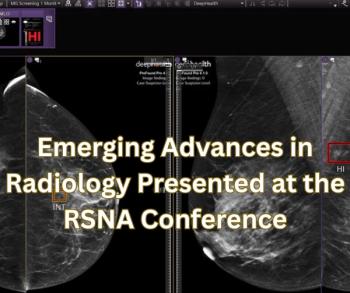
Report from SIR: Thoracic aortic stenting outperforms surgery
Two studies presented at the 2007 Society of Interventional Radiology meeting show that endovascular stent-graft treatments of thoracic artery injuries and disease carry a lower risk of neurological damage or death than open surgery.
Two studies presented at the 2007 Society of Interventional Radiology meeting show that endovascular stent-graft treatments of thoracic artery injuries and disease carry a lower risk of neurological damage or death than open surgery.
Interventional radiologist Dr. John F. Reidy and colleagues at Guys Hospital in London and colleagues retrospectively evaluated 190 patients treated between 1997 and 2006 with thoracic stents. Thoracic aortic indications included degenerative aneurysms, dissections, and ulcers.
The investigators found that fewer than 2% of these patients died or suffered permanent paralysis after a mean follow-up of 34 months (range: three to 96 months).
Percutaneous endovascular repair is much less invasive than open surgery, does not interrupt the blood supply, avoids general anesthesia, and has a reduced risk of infection, Reidy said. Yet surgery remains the standard of care for thoracic aortic aneurysms and tears produced by vascular disease or traumatic injuries. Surgical repair requires clamping the aorta and thus increases a patient's risk of paraplegia because of the lack of blood supply to the spine.
"Compared with surgery, the interventional treatment has a much lower risk of paralysis, less than 2%. Open surgery has approximately a 10% risk, even in the best of hands," Reidy said. "Repairing a thoracic aorta should be done with a stent-graft."
In a study from Canada, University of Alberta interventionalists assessed 82 patients presenting with acute traumatic injury to the thoracic aorta between April 1995 and September 2006. Of the total, 19 received conservative therapy, 36 underwent open surgery, and 27 received minimally invasive stent-graft repairs.
Dr. Richard Owen and colleagues in Edmonton found that the incidence of death, paralysis, and adverse events was significantly higher for patients who underwent surgery compared with those treated with stenting.
Of patients who underwent surgery, 11.1% died on the operating table or within 30 days of the procedure. After a mean follow-up of 61 months, 12.5%, 15.6%, 9.4%, 37.5%, and 3.1% had suffered from intrathoracic nerve damage, paraplegia, paraparesis, pneumonia, or renal failure, respectively.
About 7% of patients who underwent stenting died within 30 days of the procedure. With the exception of pneumonia (7.4% rate), however, these patients reported no other major complication during a mean follow-up period of 17 months.
Endovascular repair is slightly more expensive than surgery. In the context of traumatic thoracic aortic injuries, however, it provides a lower perioperative mortality and morbidity and less physiological stress to patients, said coauthor John Chung, a medical student at Alberta.
Data strongly suggest that endovascular repair should be considered the treatment of choice in these cases, Chung said.
For more information from the Diagnostic Imaging archives:
Newsletter
Stay at the forefront of radiology with the Diagnostic Imaging newsletter, delivering the latest news, clinical insights, and imaging advancements for today’s radiologists.




























